This is chapter four of a book I’ve written concerning the 52 witnesses that appeared and gave public testimony before the House Select Committee on Assassinations. Ida Dox gave her very brief testimony, only 11 questions, on September 7, 1978, in the Rayburn House Office Building, though the majority of testimony was given in the Cannon House Office Building.
I tried to do with Ms. Dox, as I did with all of the witnesses, and that was lift out the salient points and update the evidence when necessary.
The name of my book is Hidden In Plain Sight. It is an attempt to demonstrate that a large amount of evidence was obvious early in the investigation of the case. In other words, it was there all the time, but we didn’t see it, sometimes because we weren’t looking for it.
Ultimately, it is a guide that will tour you through the labyrinth of testimony and evidence of the case in 1978 and then updated as the years have gone by.
Chief Counsel Robert Blakey told me in an interview in the late 90’s that these witnesses were a way for the HSCA to present their evidence to the American public.
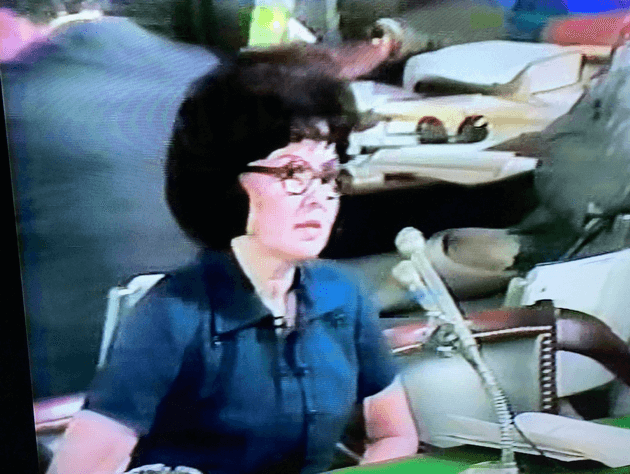
On September 7, 1978, 9:09 a.m. session, EDT—Room 2172, Rayburn House Office Building, Washington, D.C., the House Select Committee on Assassinations took testimony from Ms. Ida Dox.
Ida Dox was born on July 8, 1927 in Honduras, Central America and came to the United States in 1947. She received her Bachelor of Fine Arts from Newcomb College of Tulane University in New Orleans in 1950. She obtained her Master of Science degree from Johns Hopkins University in 1954 and her Doctorate of Philosophy from the University Maryland in 1990.
She was a medical illustrator at Georgetown University Medical Center in Washington D.C. from1954–1969. She was chosen to be the medical illustrator for the Select Commission on Assassinations of John F. Kennedy and Martin Luther King, Junior of the United States House of Representatives in Washington D.C. from 1978–1979. She has been a medical illustrator and author, in Bethesda, Maryland, since 1969.
At the time of the public hearings, she was a medical illustrator for the Department of Medical-Dental Communication at the Georgetown University Schools of Medicine and Dentistry. She was also an author of many textbooks on illustrated medical dictionaries, one of which I purchased off of Amazon.
She died on October 18, 2013, at the age of 86. Dox was her maiden name, but her married name was Ida Melloni, as she married John Melloni in 1954.
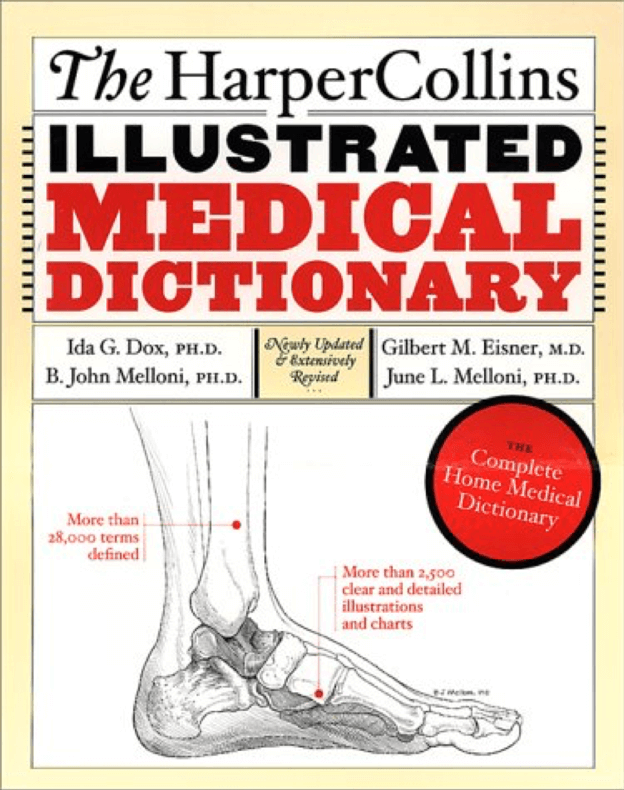
The House Committee on Assassinations contacted the Georgetown Medical School, which in turn recommended Ida Dox as a medical illustrator. She appeared before the Committee to testify in public session. She had been working with the medical panel for some time and was asked to explain her role, working with the autopsy photographs and x-rays, which would demonstrate the location and severity of the bullet wounds.
Before her appearance, Robert Blakey read a list of rumors that had circulated regarding the location and nature of those wounds, specifically to JFK. Amazingly, what he stated was a lot closer to reality than the Humes, Boswell, and Finck autopsy findings.
Blakey then commented on past presidential assassinations, as they related to the specific autopsies. He marginalized the credibility of the Parkland doctors by comparing the comments of Dr. McClelland, “a massive head and brain injury from a gunshot wound of the left temple,” (an obvious misspeak and red herring by Blakey, when he understandably meant right temple) to the wholly different description of neuro-surgeon Kemp Clark, who “observed a large gaping hole in the rear of the President’s head.” Blakey further weakened the import of their testimony by stating that they only worked on the President for a short time and they were trying to save him, which was not a possibility either way.” (I HSCA 142)
If Ida Dox was to malign the rumor department, it would have been binding upon her to testify that she enhanced the wounds in the drawings that she made, especially Fox-3. More about that in due course.
Andrew Purdy, who handled much of the medical aspect of the questioning, was called upon to question Ms. Dox. He began by asking her to expand on how it was determined what to illustrate for the Select Committee. A seemingly fair question. She said, "the committee, the medical panel, and myself…decided that the photographs taken at autopsy should be copied to illustrate the position of the wounds. The photographs that were selected were the ones that best showed the injuries.” (I HSCA 146) Why would a medical illustrator be involved in that decision-making process? She’s an artist, not a doctor. She sketches and traces; she does not slice and cut.
“The photographs taken at autopsy should be copied to illustrate the position of the wounds.” (I HSCA 146) Wouldn’t the photographs illustrate that? This seems to be a wasted step. This has the appearance of an imitation of the Warren Commission, where Commander Humes told medical illustrator Harold Rydberg lies, but Rydberg followed orders, which he argued both strenuously and vociferously against years later. Dox would never argue in that same vein, unfortunately.
The Warren Commission’s excuse was that to introduce the photos into evidence would mean publishing them; did the House Select Committee on Assassinations believe that by using drawings that they could keep the nature of the injuries from becoming public? The Dox drawings are some of the least graphic of the autopsy photos that we know about, but even still, they don’t hide what little graphic nature there is in those prints. The Warren Commission could get away with it, because nobody was going to see the photographs and that was a censuring that remained in place years later, when the HSCA chose drawings, identical to a couple of the autopsy photos, instead of the photos, for their study. Nothing had changed fourteen years after the Warren Commission, as neither the Commission nor the House Committee on Assassinations, and much to their shame, put the autopsy photographs into evidence.
In her testimony of how she made the illustrations, at no time did she give any indication that the results used by the committee were in any way different from the actual photographs themselves. I am sure at some point, someone told Ida Dox exactly what to do with the red spot on Fox-3, the back of the head autopsy photograph. In fact, some of the records obtained from the National Archives do everything, except come right out and say just that. Does this make Ida culpable? Probably. I am sure she was just doing what she was told and may have been told it would illustrate what the medical panel was trying to explain. She is less culpable than Baden, to be sure.
They would never publish the photos and the drawings by Ms. Dox in the same volumes, as it would easily demonstrate the differences between the two. The differences would have been recognized immediately, particularly with reference to the wound in the cowlick, not discernable in the photograph, but manifestly obvious in the drawing.
Mr. Purdy: Ms. Dox, prior to today, did you have the opportunity to review the enlargements of your drawings to ensure that they are accurate?
Ms. Dox: Yes, I did. I looked at them very, very carefully and they are my drawings except that they are photographically enhanced. [my emphasis] (I HSCA 148)
The witness was asked if the drawings are accurate? Her answer was that she compared them to make sure that they were, in fact, her drawings and they had not been rehabilitated in any way. She had to know this wasn’t true, as the documents I received from the National Archives indicate in this chapter.
In two investigations into the murder of the President of the United States, when it comes to medical evidence, the most crucial evidence of all, the deception seems to explode all over the place.
This is a sleight of hand worthy of the Warren Commission, suggesting that the House Select Committee at least had a tutorial in coverups; they agreed for the sake of the Kennedy family’s privacy not to use the actual photos, but to use identical sketches made by a medical illustrator.
I am not sure how that would have put anyone at ease in the Kennedy family. The President’s image was displayed, in death, and on television. Whether it was a photograph or a true rendering by a medical illustrator, it is truly much ado about nothing. The American public had already seen the graphicness of the Zapruder film on national television in March of 1975.
But make no mistake, the autopsy photo that Dox copied of the back of the head and the resulting sketch she made are ages apart. Ida Dox deceptively depicted the rear head entrance wound, exposed as such when the inquiring public was finally allowed to see the actual wounds fifteen years after the event. Who knows what she was thinking, as she did what Dr. Baden told her.
The decision not to use the original photographs was probably made by the Committee members. An arrangement was reached that they would publish the drawings, but only those deemed essential. The Dox drawing of the head wound was withheld from publication and it was not in the hundreds of pages of her file I received from the National Archives.
She also responded to Purdy's question by stating that “the photographs that were selected were the ones that best showed the injuries.” (I HSCA 146) Ms. Dox said she copied four photographs: the back of the head (Fox-3), the upper back (Fox-5), the side of the head (Fox-4) [not shown during public testimony], and the front of the neck (Fox-1 & 2). Key photos were clearly withheld, some say on grounds of taste. They were examined by the forensics panel and other experts, but not displayed or published. The top of the head photo (Fox-6 & 7) was not chosen. As stated, the side of the head photo drawn by Ms. Dox was not shown during public testimony either. She was asked to draw the head wound photo, but when they saw it, they decided not to publish it. I am not sure what they thought they would see before they looked at it, as they had seen the autopsy photograph on which it was based.
The back of the head photo (Fox-3) was shown during the public testimony of Ms. Dox. The only problem is that the alleged entrance wound in the cowlick area is much more visible in her drawing, than on the original Fox-3 photograph. Conversely, her drawing of the back wound (Fox-5) omits the possibility of an entrance wound that has been alleged by some critics and his back was cleaned up quite a bit. Whether there are other possibilities concerning Fox-5, it should have at least been drawn. It also places the back wound much too high. The autopsy face sheet, as did his suit coat and shirt, as did Dr. Humes, places the back wound in the upper right posterior thorax at about the level of the third thoracic vertebra, which would be approximately five and three-eighths inches below the top of the collar. The Dox wound appears much too high.
When Mr. Purdy asks how she copied the photographs, Ms. Dox stated that she did it by “placing a piece of tracing paper directly on the photograph, then all the details were very carefully traced…so that no detail could be overlooked or omitted or altered in any way.” (I HSCA 147) As noted, the upper entry head wound was altered. Period. Perjury, most likely, but I really believe it is more of being afraid to disagree with Dr. Baden, when he had told her what he wanted. Hard to tell. Things were omitted, especially on the back wound (Fox-5), where obvious detail is missing, and also on the back of the head wound (Fox-3), where the alleged cowlick area wound is much clearer and pronounced in her drawings than in the autopsy photographs themselves, as I stated earlier. Isn’t this really much ado about nothing? Couldn’t all of this have been avoided knowing that the drawings are no substitute for the photos? The original photos should have been available to researchers at least as soon as the Warren Commission closed up shop, but legally they haven’t been released to this day.
Purdy goes on to say that Ms. Dox made other drawings to illustrate the conclusions of the forensic pathology panel. We are not exactly sure what these other drawings are, only to assume they are in the Committee’s files. The release of the Assassination Records Review Board medical materials did not tell us any more on this subject. I don’t recall this issue even being addressed. The truth is, in relationship to Ms. Dox, the ARRB made no difference at all. I’m frankly amazed that nobody at the ARRB asked the obvious question: Why are the Dox drawings and the photographs from which they are exactly made, so different? Sadly, Ms. Dox was not questioned by the ARRB and she could have been, since she didn’t pass away until 2013, but this was never addressed.
In her next to the last question, Ms. Dox says that a frame of “film taken during the motorcade was photographed and the outline of the President’s head was used, so that the…head of the President…in the position that the medical panel decided was necessary.” (I HSCA 147-148) They were probably doing what they thought was adequate, but left themselves open to immense criticism, just as the Warren Commission did.
Ms. Dox worked for the Committee, under the direction of Professor Blakey. In that capacity, she was assigned to assist the Committee by preparing drawings from the autopsy photos for possible publication. She was working under Blakey’s direction and Dr. Baden, or perhaps Andrew Purdy’s, since he guided most of the medical aspects of the case. Ultimately, Dr. Baden made the call on what Ms. Dox drew and, in some cases, how to draw it. As you listen and read the testimony of Ida Dox, you can only reflect about what should have been asked.
I contacted Ms. Dox in October of 1999. I had two conversations with her on the telephone. It all started with a question I had regarding HSCA Exhibit F-302, which was a drawing of President Kennedy’s brain, that was put into evidence during the testimony of Dr. Humes. What followed was both puzzling and frustrating. I will go into detail about what Ms. Dox said about that sketching of JFK’s brain, parts of her testimony that she now denies ever saying, enhancement of the wounds that she drew for the Committee (which has to do with some correspondence between her and Dr. Baden that I requested and received from The National Archives and publish in this chapter), and other sundry matters.
I prepared for my conversations with Ms. Dox by reading documents I received from the National Archives concerning her. There was a sense of discovery, but more so of clarification. I’m not one who looks for a demon under every shingle, nor is it my purpose to attempt to discredit someone who appears on the surface to be a nice lady who was just following orders and instructions. There were some things that did seem a bit odd and other things that I still don’t understand as I write this. The following information is based on those two telephone conversations I had with Ms. Dox.
In the first conversation I had with here on October 14, 1999, I asked her the following questions:
Question #1: How many photographs were you shown?
When I asked Mrs. Dox this question on the phone, she quickly replied, “I can’t remember.” This is intriguing. If she had been shown 75 photos, okay, she can’t recall, but she testified before the HSCA that it was four, at least that is how many she drew. She doesn’t seem to be guessing before the HSCA during her public testimony. I don’t care how many zillion wounds she has illustrated, as one of the first humans on the planet to see those autopsy photos of JFK, you would think she could remember the number. Maybe not perfectly, but certainly not, “I don’t remember.” Even an estimate would have been nice.
Question #2: Were you ever shown a photograph of the brain?
She emphatically stated, “No!” This first surfaced for me when I noticed HSCA exhibit F-302 in David Lifton’s book, Best Evidence. During Dr. Humes’ testimony, exhibit F-302 is introduced, with no data whatsoever. It is said, then, to be a drawing of the brain. There are two kinds of representations in Lifton’s book. In the cases of the actual line drawings, they are represented in full, the throat wound, cropped so as not to show the face. The brain drawing, however, is in mid-text, so that may be why it is different from the others. It also has no signature on it. The other Dox drawings are reproduced in full and have a signature in the lower corner. It may have been a simple matter of a tracing of a tracing, or some sort, so it could be reproduced in text, without going to the photo section, which is different paper.
The only available rendering of the brain, however, absent the photographs, is the drawing/tracing created by Ida Dox and I have already noted my criticisms of her efforts. In her brain illustration, the left cerebral hemisphere is intact, while the right cerebral hemisphere resembles a swirling pattern.
The two lobes of the cerebellum are intact and unremarkable. That flies in the face of the doctors from Parkland, who testified to seeing cerebellum extruding from the large wound in the back of the head and here we are presented with no cerebellum damage and no large wound in the back of the head.
Question #3: Were the wounds enhanced for the sake of clarity?
Her response, “No, of course not.” This is interesting. At Wecht 2003, I asked Dr. Baden about this and was told that Dox was given other gunshot wounds to draw in order to enhance the visibility. You have to look for something even resembling a wound in the Fox-3 photograph. It looks more like a blood droplet, but not a bullet wound.
He told me that Dox had been given other photos (see later in the text for the documents), of other individuals with wounds, in order that she would be able to highlight JFK’s wound, so people wouldn’t miss where the actual head wound was. Other researchers have talked with Dr. Baden about this and received similar responses.
What follows after this paragraph is a copy of the Dox drawing of Fox-3 and the actual Fox-3 autopsy photo and then a few pages of documents I received from the National Archives, both of which were sent to Ida Dox by the HSCA, including “you can do much better, Ida,” from Michael Baden. How can you do “much better” than the autopsy photos you are directly looking at and tracing. Or, is “much better” referring to placing a bullet wound where there isn’t one in the cowlick area? Ida Dox lied to me on the phone, when she said she wasn’t given any pictures to use to enhance what wasn’t there. Here are some of the documents I got from the Archives, after I requested every document they had concerning Ida Dox. Unlike the Ida Dox drawing, the actual wound is not visible in Fox-3 and no other photographs show it either.
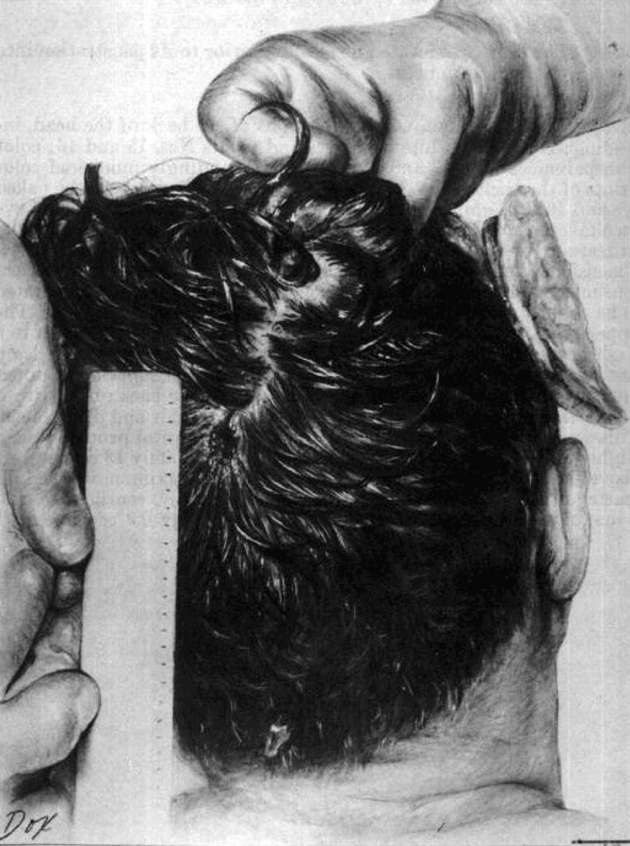
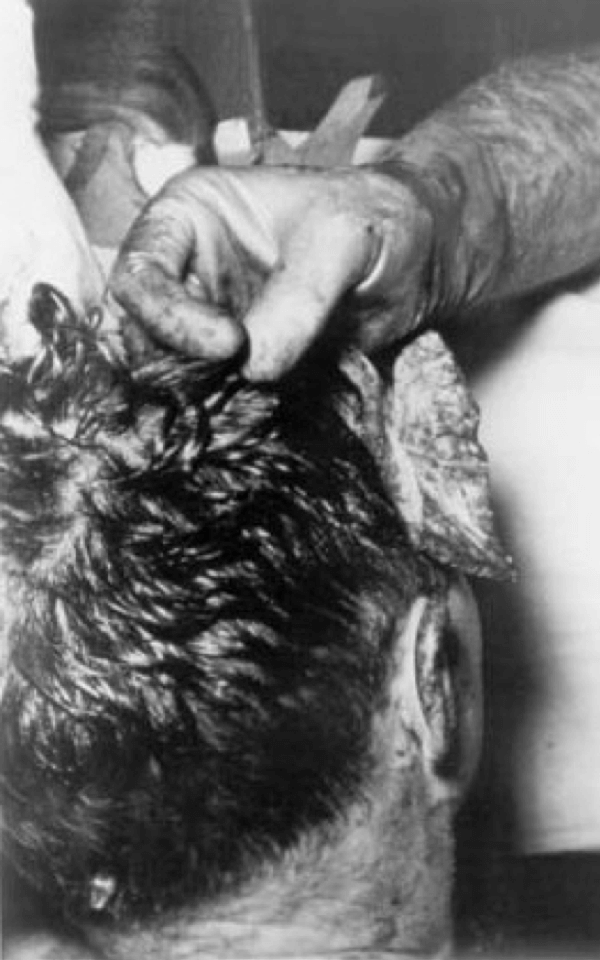
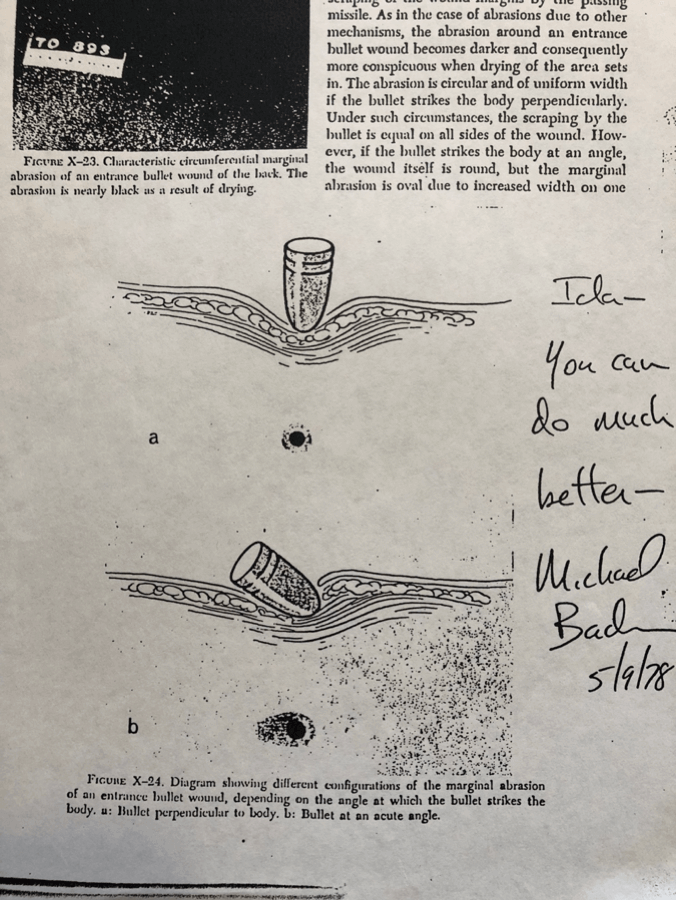
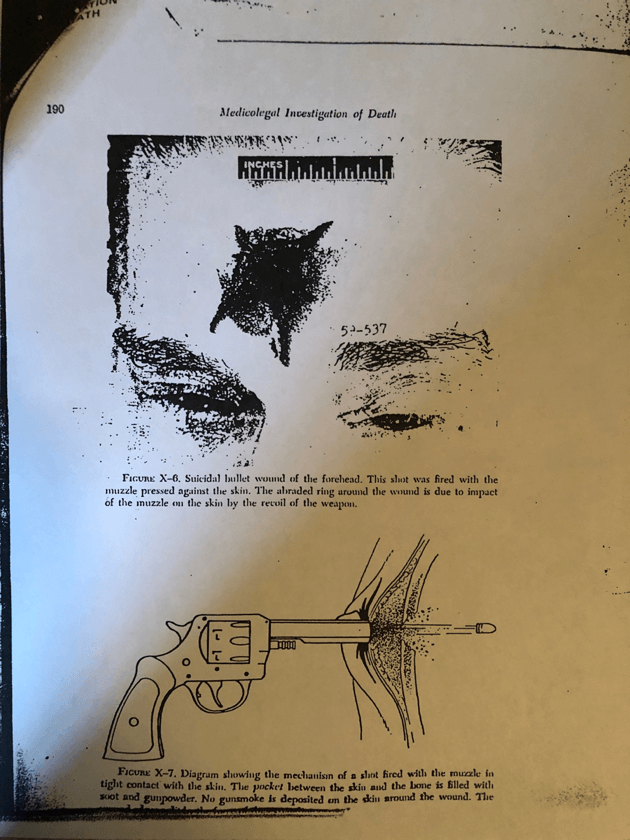
The Forensic Pathology Panel of the House Select Committee was so thoroughly caught up in their findings, that the upper artifact, the red spot, and what they said was the actual entry wound, that they failed to realize how badly they had been duped.
This is critical to the ongoing investigation and needs to be considered again. Originally, the HSCA worked from medical illustrations, done by medical illustrator Ida Dox. Unfortunately, Ms. Dox, who was allowed to commit perjury before the House Select Committee, altered the wound that some have identified as simply a red spot or droplet.
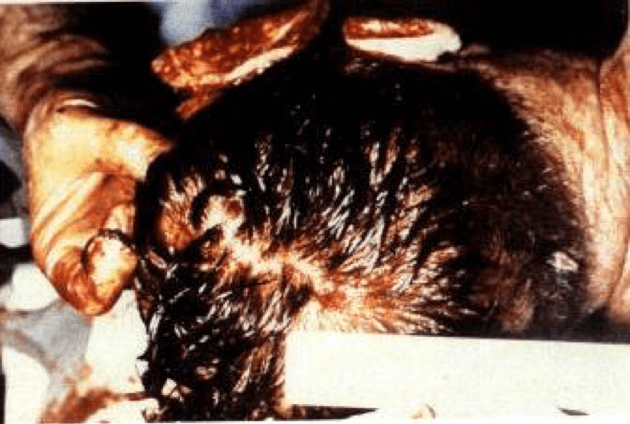
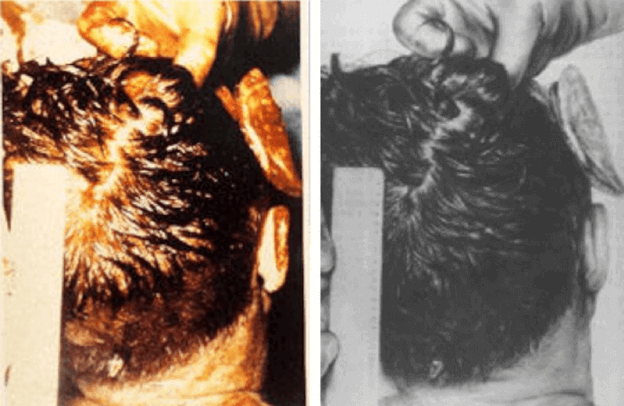
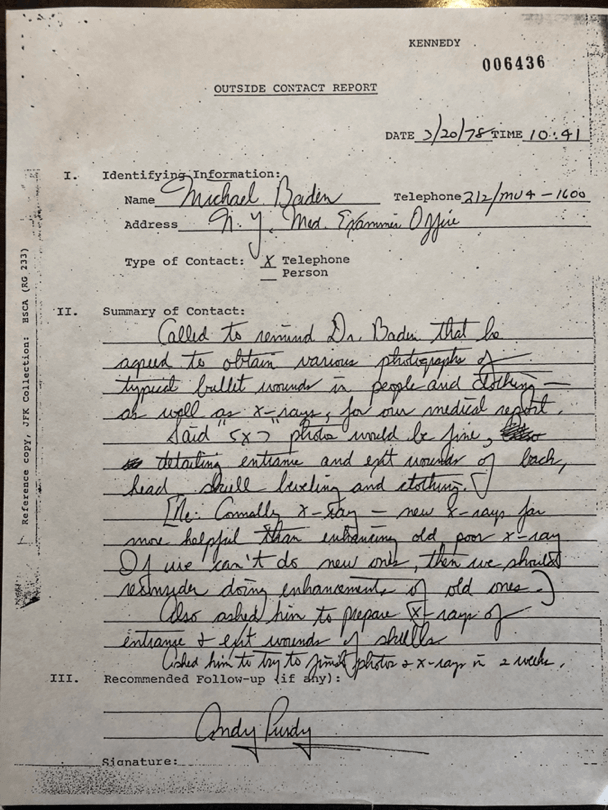
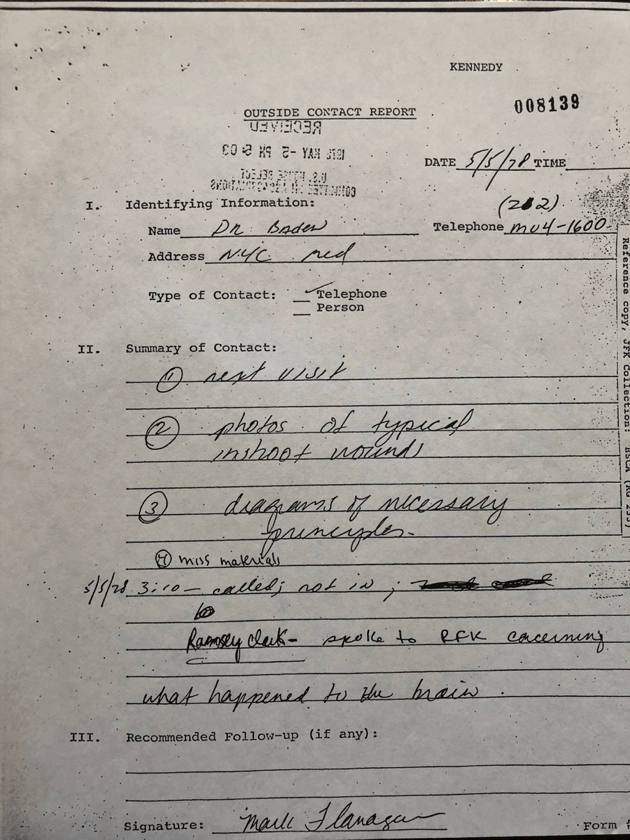
Any assessment of the photographs show nothing even slightly comparable to what Dox drew. I often show the autopsy photos to friends or at talks I give at local libraries and they always produce the same shocked reaction. I show them the Fox photo of the back of the head and ask, “Do you see the entrance wound?”
Nobody can ever see the entry. Then I show them the Dox drawing of the back of the head and ask if the wound is visible and unanimously and they say it is. Then I put them side-by-side and there is usually some kind of verbal gasp, as if they were watching the Zapruder film for the first time.
Now they can see up close and personal that something sinister was going on with the medical evidence. The alteration becomes obvious.
Ida Dox was given the autopsy photographs and requested to make sketches for the HSCA, a procedure that, in itself, calls into question the sanity of the people doing it, as a drawing of gore is almost as unpleasant as a photo of gore.
The reader is invited, even strongly urged, to view the photographs in question and then view the same cowlick area in the Dox (Fox-3) drawings. You will be surprised, if you have never done this before.
What is cited as an artifact and is not by any means proof of an entry wound in the photograph, becomes a glaring bullet hole thanks to Ida Dox, who was given additional photos as stated, showing bullet wounds of other people and not of John Kennedy, so that she could highlight and forge the JFK sketches. There is no doubt in my mind that the reason for moving the back of the head wound four inches higher is to explain the massive wound in JFK’s right temporal area of his skull. If you move the wound, then you have a perfect inshoot-outshoot scenario. If not, you have to explain how a bullet traveling downward from sixty feet in the air and behind can emerge on the upper right side of Kennedy’s temporal bone.
The explanation I can assert is what I have already said in chapter one concerning Governor Connally, that a second head shot at c. Z-327, 7/10ths of a second after Z-313, explains this precisely and, if so, then there was no need to invent a head wound in the cowlick area, as Z-327 explains it perfectly. What is disheartening is that chapter one on Governor Connelly documents that the HSCA was suggesting a shot c. Z-327, but then the Committee wasn’t (as it was a Select, not a Standing committee) renewed and the data became inactive.
That alone brings into question the honesty of the entire HSCA investigation and the charge against Dox is not a pointless one. The question then becomes two-fold:
- Why, (excepting the necessity to maintain the lone-assassin fiction) was the wound altered in order to make it obvious to any John Q citizen viewing the Dox drawing, when trained pathologists could not and did not identify it from the photograph which Dox claimed she copied exactly?
- Whose decision was it to alter the wound and whose decision was it not to make the obvious comparison between the actual photo and the altered drawing during the HSCA hearings? Baden seems to be candidate number 1.
A little background on Baden and the Clark Panel is probably appropriate at this point. In the late 1960’s, the public was screaming for a reinvestigation. David Slawson at the Department of Justice wrote a memo to Ramsey Clark explaining that if they don’t do something the conspiracy fringe will get Congress to reopen the whole thing. It also is happening at the same time as the Garrison investigation, which scared the intelligence community, so they needed to calm the storms in Louisiana. Slawson suggests an investigation limited to the medical evidence and so the Clark panel is born. The Clark Panel relocates all the wounds, four inches higher on the head and four inches lower on the back. Why? If left where they were in the autopsy report, then Oswald didn’t do it. The plan succeeds and the public is quieted. Meanwhile, the prominent pathologists, having been thrown together to make up the Clark Panel, decide together to write a book on pathology. Ramsey Clark writes its forward. A young, inexperienced pathologist named Michael Baden is asked to contribute to the book. It’s not much, but associating his name with theirs launches his career.
Ten years later, Baden is asked to head the HSCA’s medical panel. He insists he not serve on it alone, so that there is no question of impropriety, so he fills it up with friends, save a lone critic named Dr. Cyril Wecht. Before they would ever meet, Baden went in to examine the autopsy materials. He then sat down and wrote a memo which echoes every point made in the Clark Panel report. He moved the wounds and to the exact same points they had chosen.
At the first meeting of the medical panel (Baden is the only panelist to have seen the materials at this point, though Wecht had gotten permission to see them in the early seventies), he presents them with his findings and calls for a vote to see if another meeting of the panel is necessary. Wecht says yes. The record does not reflect how the others voted, but plans for the other panelists to see the materials were not initiated for several weeks.
This brings us back to Dox and Baden. Dox is permitted to see the photos and to make a set of drawings, which she denied to me on the telephone (though this is exactly what she stated in her public testimony in September of 1978). She then leaves them for Baden to approve. Baden sees the drawings and calls Purdy, who writes a memo to himself that says, “get a photo of a typical wound of entry.” (In another memo dated 4/24/78, Purdy states that he needs to remind Baden to get wound comparison photos and X-rays.) The next document in the record is a photocopy of a page out of the pathology book Baden and the Clark Panelists wrote. At the top of the photo of a tiny bullet wound to the head, Baden wrote, “Ida you can do much better.” Again, and as I stated earlier, I am not sure how you outdo the original autopsy photos. So better, in what sense? Location? The wound itself? Quite baffling, if not disturbing.
On October 28, 1999, I called Ida Dox for the second time. She hung up on me at the end our first conversation. This time the conversation lasted a bit longer and was much more detailed. The following questions were asked Ida Dox at this time:
Question #1: Did you see color or black and white photographs?
She quickly said, “Color.” The color photos certainly show the wounds better, but still not as good as the Dox tracing. You would also think that black and white would be better to trace from. The fact that a lay observer can tell in a second that the tracings are accurate, except for the wounds, should raise questions immediately. The aforementioned data, along with the Baden and Purdy memos speak volumes to this point.
Question #2: I asked her again about how many photographs she saw?
This time she got defensive. I simply reminded her that my previous notes stated that she could not recall, but that she had stated in her testimony that she had drawn four. I was seeking clarification and thought, perhaps, there was a possibility she had been shown others. I was very polite and was genuinely not trying to trick her or confront her in any way. She was silent and so I proceeded.
Question #3: I asked her if security was tight while viewing the autopsy photographs in the National Archives?
She indicated that security was very tight. I was reminded that RFK was in a panic that such stuff would go public. It was difficult enough that the Dox drawings went public, but something had to. Her public testimony suggests she had worked from some kind of originals while being watched at the Archives. This led me to the next obvious question.
Question #4: Did she have a set of autopsy photographs made, so as not to take up the Archives’ employees’ time?
At this point she got very defensive, especially when I read her public testimony where she says this is exactly what had transpired. I was lucky the conversation went any further at all, as she was not happy. I was not accusing her of anything, still only seeking clarification. Her testimony, again, indicates she was given knock off copies to use outside the Archives, as she added detail like Humes’ gloves, so as not to keep the Archives busy.
Question #5: I then asked her again if she had drawn F-302, which is JFK’s brain?
She simply said, “I can’t remember.” I don’t care if it has been twenty years plus, you can’t tell me that you wouldn’t remember drawing a picture of the brain, which just happens to be of the President of the United States! The absurdity of this is beyond belief. Exhibit F-302 does come up during Dr. Baden’s testimony. He uses the drawing of the brain, which he says that Ida Dox drew, to show the intact nature of the cerebellum, thus attempting to prove that Dr. Humes et. al. could not possibly be correct in locating the entrance wound to the rear of JFK’s head in the area of the external occipital protuberance. It wasn’t until Dr. Humes’ testimony that F-302 was formally entered into evidence.
During the session at the end of each testimony, when everyone is given five minutes to ask questions if they want to, Mr. Fithian asks about the possibility of metal fragments being in the brain. In Baden’s testimony, he displayed F-302 and says that in the right, front area side of the brain there was an oblong, blue discoloration, but that it was not a metal object. He stated that the Forensic Pathology Panel determined that it was blood vessels that had been sheered away. Baden went on to explain that there were many pictures taken of the brain and that some had toothpicks in the damaged part for identification purposes by the doctors at the autopsy.
It still, however, doesn’t explain why Ms. Dox told me that she never saw any photographs of JFK’s brain, let alone drew them for the committee. Dr. Baden said there were several pictures of the brain and that Ms. Dox drew from them for the committee to illustrate for the Forensic Pathology Panel, that the cerebellum was not injured because of the rear entrance head shot to President Kennedy (I HSCA 304).
Question #6: Did the photographs of JFK’s neck wound show the face as well?
She told me that the pictures did show his face and that there had been some talk of blurring the face. The tracings, however, do not show the face of the President. That was all she addressed with this question.
Question #7: I again asked her if she was shown other photographs of wounds in order to enhance the ones on her tracings/drawings?
She got very defensive and refused to talk any further. In fact, she said, “I don’t think I want to talk about this any further.” I again tried to assure her that I was not attempting to confront her, only clarify what I had discovered from other researchers and documents from the National Archives. This didn’t seem to quell her anger, but she suggested I contact Professor Blakey, which I did. The data from the first conversation has already dealt with this question in full, but nonetheless, I thought I would give her another chance to verify what I had documentation for from the National Archives. I still refuse to believe you would forget doing something like this, especially in reference to the President of the United States. I don’t care how much time has passed, certain events in our lives are indelibly engrained in our psyche. This event would have to at least be up for a possible nomination.
Question #8: I asked if there were any other medical illustrators besides her?
She told me that she was the only one. In fact, she also worked for the Committee on the tracings/drawings concerning Dr. Martin Luther King, Jr. She received $16,000, not counting $125 per day, plus expenses for services rendered. This also included appearing as an expert during the public hearings. She was not required to write any reports, only that her medical illustrations would appear in the Committee’s final report. She spent 125 and one-half days consulting and providing services. The final tally, financially speaking, would be: $31,625, plus expenses. That’s not bad money for 125 days’ worth of work, especially in 1978.
Question #9: I asked her how long it took to make the illustrations?
She was kind enough to explain that it took a long time, months as far as the entire process, and that it is very tedious work.
There were some things that were missed in her public testimony, that was gone over with her in her practice questions beforehand, which I still have copies from the National Archives. She was supposed to mention that she was to duplicate the autopsy photographs which show the key wound areas, reconstructions of wound areas with internal structures, and illustrate what happens to soft tissue and bones when they are struck by bullets. Most of these can be seen in Volume I of the HSCA Hearings when Dr. Baden is testifying.
She also stated in her practice questions that blood on the skin and blood on the gloved hands were removed, as well as background details. She stated in her public testimony that she worked very closely with the medical panel, especially Dr. Michael Baden. Based on the previously mentioned discoveries from the Archives, her statement was only the tip of the iceberg.
All in all, I found Ida Dox to be somewhat reticent to talk about the issues that I brought up to her. She was kind and cordial, but obviously on edge during the two conversations. I was never aggressive or combative, only attempting to clarify what I had discovered. I was told by one researcher, in reference to my questioning her about whether she drew the brain, that it is hard to believe that something called the Dox drawing and entered into evidence (or at least referred to constantly) during the hearings, that were nationally televised, could now be credibly disclaimed as not being her work. He told me to think about what I was suggesting here. I never suggested she didn’t draw F-302 (the brain), only wondered why she didn’t sign off on it, when she did on every other illustration. I also was puzzled as to why she would deny something like this; I wasn’t implying something sinister.
I was also told that I was probably running into a simple failure of memory, after two decades. I was cautioned not to go down this path and get involved in a hypothesis alleging major forgery of evidence, when all I had was a simple error of memory.
I really did appreciate the words of caution and took them seriously. I generally respect my colleagues in this field and take their words thoughtfully. I wasn’t implying forgery of evidence or even questioning whether she had drawn the illustration of F-302, again, only seeking clarification of the data I had before me. It made me question the integrity of Dr. Baden more than that of Ida Dox. She was merely following orders and protocol; the others, well, I’ll leave that up to each individual researcher to decide.
A Final Comment: The fourteen questions they asked Ms. Dox is nothing but procedural, chain of evidence testimony and makes no statement about that which was under scrutiny, except that it is frightfully dishonest, and certainly Ida Dox had to know it when she was testifying.
The first question that needed to be asked was, Why were so-called exact drawings or tracings necessary to be used in place of the actual photographs?
There is absolutely no rational answer to this question. It does not seem like it was done out of respect for the President or the President’s family, because the drawings are just as graphic as the original photographs in some areas.
Certain background material had been removed from the tracings. In the drawing which shows the circular bone extending from the right-front scalp, the inference from the drawing would be that the photo would have been taken with the President’s body posed, sitting up.
In actuality, the body was laying on its left side. In the photo, one of the pathologists looms up from Kennedy’s side as the pathologist is standing and Kennedy is on his side on the examining table.
If there can be one reason attributed to the use of drawings, it was to certify that which the House Select Medical Panel wanted. I have written elsewhere that a number of researchers have noted the difference between the photographs, particularly the back of the head photo, with its absence of any visible wound, and the Dox drawing, which clearly showed an obvious entry wound in the cowlick.
The difference has to be placed in time perspective. As Dox noted in her testimony, she was under observation all the time while she was working at the National Archives with the originals of the photos. Yet she could have access to copies of those photos, to complete the tracings of the doctors’ hands, or rulers, in HSCA rooms.
In 1978, those photographs had never been seen by the general public and an individual could only get into the National Archives to view them if they were a medical doctor.
Thus, the first time the wounds were truly seen in some manner other than the Zapruder film or the absurd Rydberg drawings, contrived for the Warren Commission, were the Dox drawings.
And therein lies the reason for the drawings. With the Fox photographs in my possession, and other researches too for some time and prints available in quantity, it was clear that the back of the head photo and the back of the head drawing were very different.
From here, it was now a matter of forcing Commander Humes to change his testimony to reflect that the cowlick entry was the correct site and not the original autopsy finding, located four inches lower. Humes refused to change his findings when testifying before the Medical Panel, but he sold out altogether when he was on television in front of the HSCA itself.
He moved both wounds—the head and the back—approximately four inches. Disgraceful.


